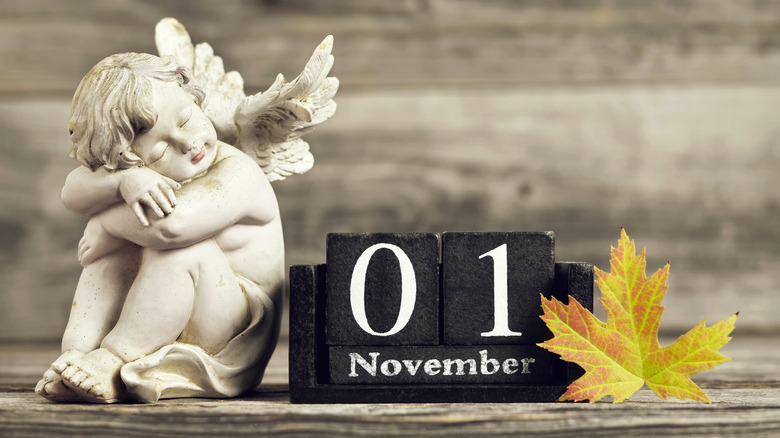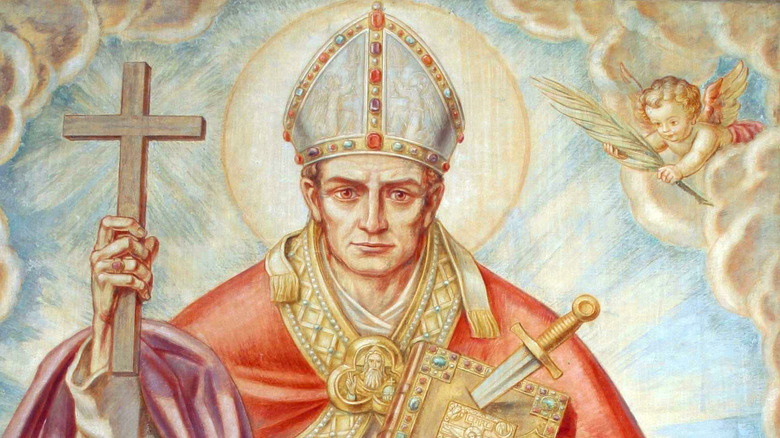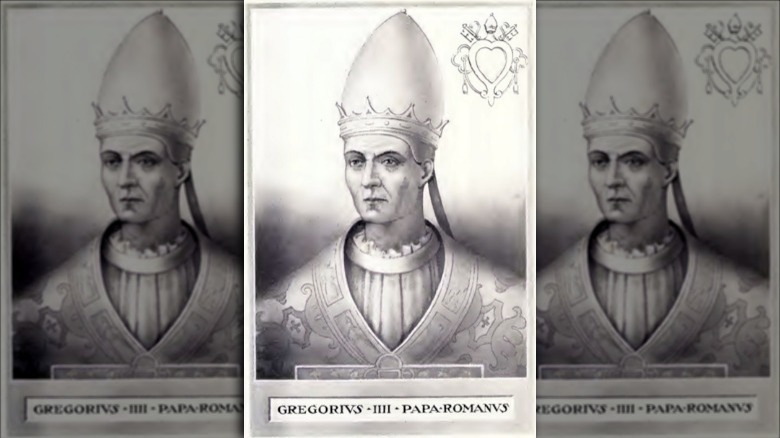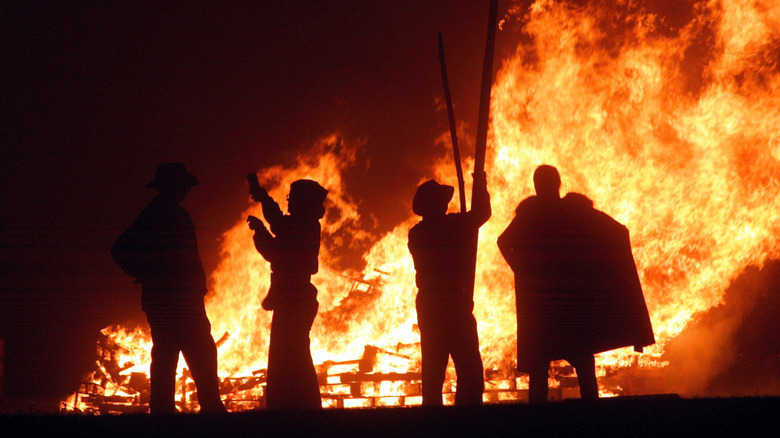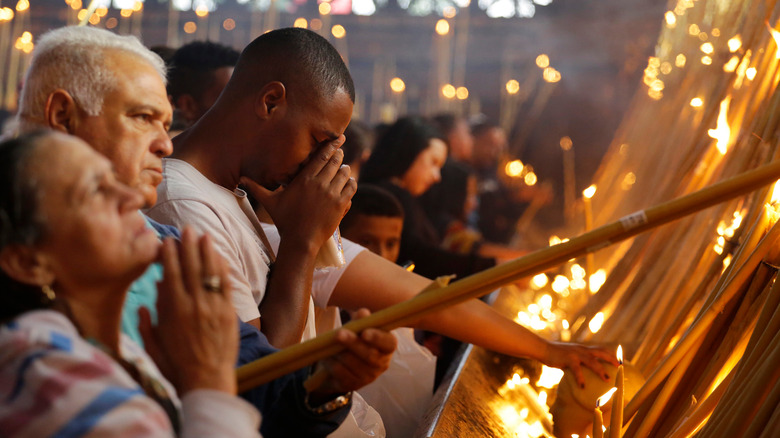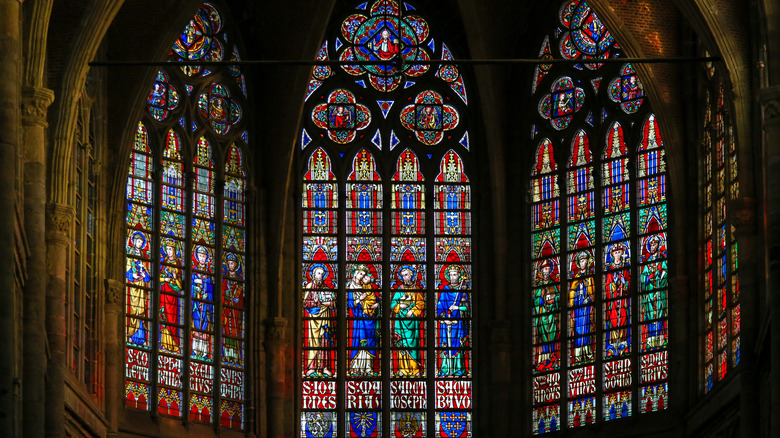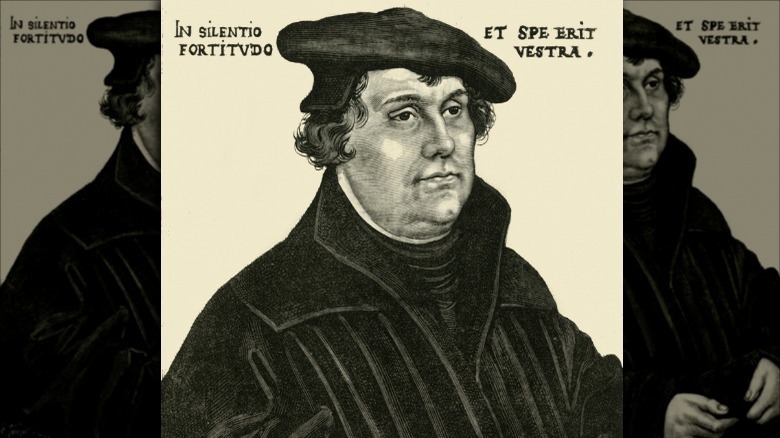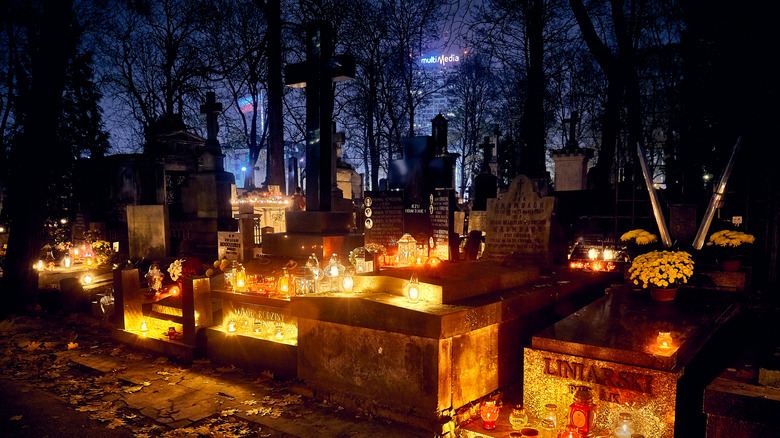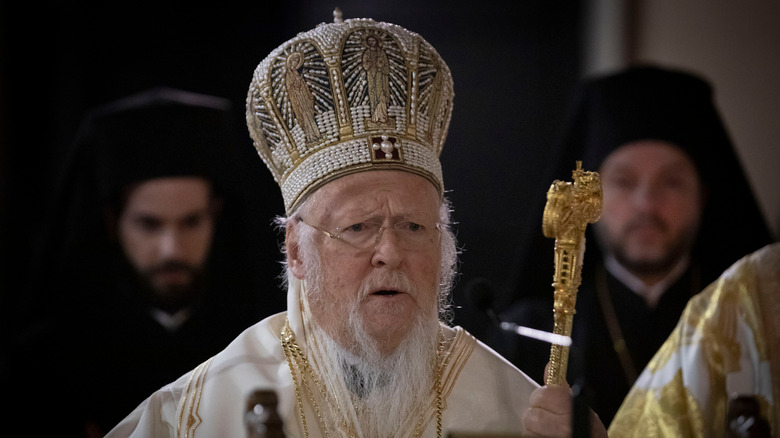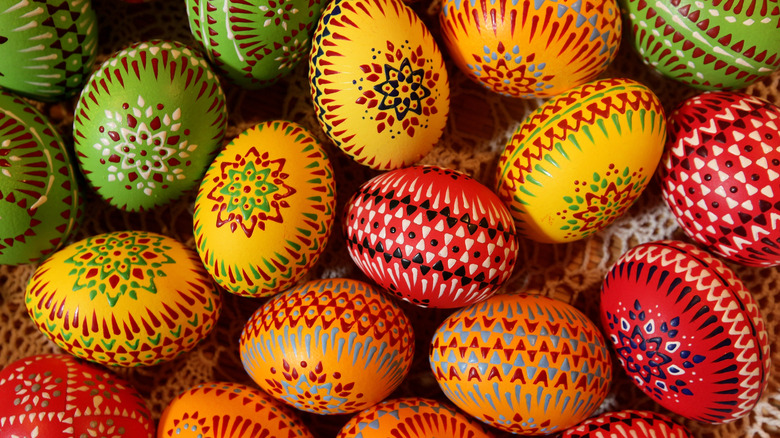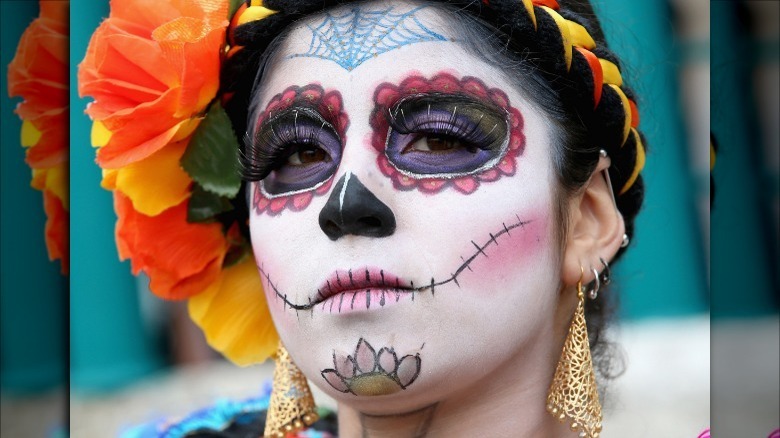The Untold Truth Of All Saints' Day
Every year, Halloween a lot of attention in the U.S. It's easy to see why. Permission to wear costumes everywhere? Check. An excuse to eat an unhealthy amount of candy? Check. Parties? Adorable children marching in Ragamuffin parades? Check and check. The moment the leaves start to turn and the calendar says October, it's pretty much all Halloween, all the time.
For many, all of that excitement consigns the day after Halloween — All Saints' Day — to an afterthought. Some folks use All Saints' Day to recover from their Halloween celebrations, the faithful might go to church, but few of us think about what the day means or why it's on our calendars in the first place. But not only has All Saints' Day been a part of Christianity for a very, very long time, it's actually a lot more important — and interesting — than you might think. Here's the untold truth of All Saints' Day.
It originated in the 7th century
All Saints' Day has been part of the Christian tradition for a very long time. According to Christianity.com, it dates back to the early 7th century. The Roman Empire was originally a polytheistic culture that worshiped many gods, and when Christianity began to rise there were periods of intense persecution, and many early Christians died.
For example, PBS reports that after the Great Fire of Rome in 64 A.D., Emperor Nero sought to distract the unhappy public by attacking Christians — at the time a small and little understood sect. He had many arrested, tortured, and publicly executed. Christians were targets of official state terror for hundreds of years, with the last major period of violent persecution occurring under Emperor Diocletian in the early 4th century, according to Britannica.
But by the 7th century Rome was officially Christian, and Emperor Phocas gave the Pantheon — a temple dedicated to the many gods of Rome's original religions — to the pope. Owlcation reports that Pope Boniface IV consecrated the Pantheon on May 13, 609 A.D. Britannica explains that Boniface dedicated the day to the Virgin Mary, the mother of Jesus Christ, and to all the martyrs who had died in the persecutions of the Christians over the years — not saints specifically, but martyrs. This early version of All Saints' Day would remain on that date for more than 200 years.
Everything changed in the 9th century
After being established as a local feast day in the year 609, All Saints' Day remained that way for more than two centuries. CNN explains the holiday was actually limited to the city of Rome during this time. It also remained focused on the martyrs who had died for their faith, not specifically saints. BBC Religions reports that the original name of the day was the Feast of All Holy Martyrs.
All Saints' Day's shift to November 1 was gradual, as more and more Christians began observing it even though it wasn't a requirement. According to Britannica, in the mid-8th century Pope Gregory III dedicated a chapel in Rome to all saints on that dates, and there are sporadic mentions of All Saints on November 1 in other church records. But it wasn't until the year 837 that All Saints' Day was officially moved to November 1 by Pope Gregory IV. It was officially made a day of obligation for the entire church, expanding it beyond the borders of Rome. Gregory also renamed the day the Feast of All Saints to signal its shift to a celebration of all saints, martyrs or not, reflecting the Church's newfound stability and dominance.
The date may have been chosen to compete with pagan celebrations
Feast of All Holy Martyrs, as All Saints' Day was initially known, was celebrated on May 13 for over two hundred years, according to BBC Religions. Then, in 837, Pope Gregory IV officially extended the day to all Christians, changed its name to the Feast of All Saints, and changed its date to November 1.
Many historians suspect the date change was motivated by a desire to co-opt and compete with Samhain (which History explains was an ancient Celtic harvest festival) and other pagan holidays that people continued to celebrate despite the spread of Christianity. HowStuffWorks reports that this was a common tactic of the early Catholic Church and was part of an effort to bring people into the religion — the dates of many Christian holidays, like Christmas, may have been chosen for this reason. In fact, according to History, the Church incorporated certain Samhain traditions into All Saints' Day to make the transition more natural, like lighting bonfires and wearing costumes to ward off evil.
Many Christians weren't entirely comfortable with some of these pagan traditions, and the Church eventually created All Souls' Day on November 2 to separate the "festival of the dead" aspects of Samhain from All Saints' Day.
It's not a feast, it's a solemnity
Most people refer to All Saints' Day as a feast day in the calendar of the Catholic Church, but that's not technically correct. It's actually what's known as a solemnity.
As explained by Simply Catholic, the Church Calendar actually has three designations for special days: feast days, memorials, and solemnities. This stems from the 16th century Council of Trent, which took the chaotic mess of locally-devised observances and organized them into a single, global church calendar for the first time. That required not just standardizing which days would be observed and when, but also the level of importance that each day carried.
Prayerist notes that solemnities are actually the highest-ranking and most important holy days in the Church, followed by feasts and then memorials. The term "solemnity" comes from the Latin word sollemnitas, which means "festival." Solemnities honor important events in Jesus's life as well as the most important mysteries of faith in Catholicism. All Saints' Day is actually ranked with the same importance as Christmas and Easter, and it's a Holy Day of obligation, meaning you're 100% supposed to attend mass, although many Bishops waive the requirement unless All Saints' Day falls on a Sunday.
It applies to just about everyone
When we think of saints, we think of very holy men and women. The assumption is usually that there aren't that many saints — after all, as the BBC explains, the process of becoming a saint can take anywhere from five to more than a thousand years, and there are many intermediate steps for most candidates. This leads many to assume that there are only a few dozen or a few hundred actual saints in the Catholic Church.
That's incorrect by a lot. Britannica reports that there are actually more than 10,000 saints recognized by the Catholic Church, with more being added over time. As noted by Chicago Catholic, even thousands of years ago here were simply too many saints and martyrs for each to get their own holy day. That's why it's All Saints' Day — it's a holy day designed to honor all the saints of the Church. Catholic Online explains that this includes both saints known and unknown, that is, the saints whose holiness is only known to God.
But even then the definition's not broad enough.Christianity.com explains that sainthood isn't granted by Church leaders — it's granted by God. All Christians are technically considered to be saints, which means All Saints' Day honors all Christians and is meant to remind members that they are all connected to each other through their faith.
Some protestants observe it, some don't
Vox explains that the Protestant Reformation splintered the Christian religion in the 16th century. Many of the protestant movements that eventually coalesced into their own distinct brands of Christianity were protesting against the corruption and visible wealth of the Catholic Church. The backlash meant that many of the practices of the Catholic Church were rejected as being too worldly, or too corrupting.
All Saints' Day wound up with a mixed bag in the Protestant world. According to Christian Today, many protestant movements rejected the concept of sainthood entirely because it appears to confer special status to some believers over others. Owlcation reports that Martin Luther, who sparked the protestant movement when he nailed his famous "95 theses" criticizing the Church to a church door in 1517, advised that saints should be honored, but not worshiped.
As a result, All Saints' Day is treated differently in different Christian religions. Christianity.com notes that the Anglican Church observes the day on November 1 just like the Catholic Church, as does the Methodist and Lutheran Churches. Evangelical denominations like the Southern Baptists and Pentecostals, however, don't observe the day. There is a growing movement to view All Saints' Day as an informal opportunity to celebrate their faith.
We get Halloween from All Saints' Day
For many people, Halloween is the main event and All Saints' Day is an afterthought of sorts. So it's easy to make the mistake that Halloween was always the more important of the two days. This was exacerbated in the 20th century, when Halloween became increasingly commercialized and turned into a consumerist holiday. But the fact is Halloween wouldn't exits without All Saints' Day.
According to Business Insider, the word "hallow" once meant "holy person" — aka a saint. The Online Etymology Dictionary explains that the word stems from the Old English halgian, meaning "to make holy." Britannica reports that in medieval England, All Saints' Day was commonly called All Hallows in reference to all the holy people they were celebrating, and Merriam-Webster notes that we actually didn't start using the term "All Saints' Day" until the 1500s.
All Hallows also used to be a much bigger deal than it generally is today, and major holy days typically began the night before with a vigil and other celebrations. This became known as All Hallows' Even ("even" is a distinct word meaning "end of the day"), which eventually became Hallows' Even, and finally Hallowe'en. The apostrophe began to vanish in the 18th century, leaving us with Halloween.
All Souls' Day is different
If you weren't raised Catholic (or didn't pay much attention if you were) you might find All Saints' Day and All Souls' Day to be a little confusing. Aside from the very similar names, they usually occur right next to each other. As explained by BBC Religions, All Saints' Day is typically observed on November 1 in the Catholic Church and All Souls' Day on November 2 (or 3 if November 2 is a Sunday).
AL.com explains the difference between the two holy days: All Saints' Day is a celebration of those who are in heaven, who have achieved God's grace. All Souls' Day is designed for Christians to pray for all souls, saints or not, especially souls who have passed on but who remain trapped in purgatory awaiting judgment. It's common for parishioners to enter the names of their deceased loved ones into a Book of the Dead at their church so they can be remembered by the congregation.
As noted by HuffPost, All Souls' Day has connections to ancient pagan traditions that believed the end of the year thinned out the divisions between the living and the dead. HowStuffWorks explains that the Catholic Church often introduced holy days like All Souls' Day to give people a Christian alternative to those pagan traditions.
It's on a different day in the East
Britannica explains that the Christian Church finally split into two rival churches in 1054, dividing into Eastern and Western parts. Known as the East-West Schism, it was the culmination of centuries of disagreements, and it's why we have the Catholic Church in the West and the Eastern Orthodox Church today.
The Eastern Orthodox Church does celebrate All Saints' Day. However, while the holy day is essentially the same, it has a different traditional origin in the Eastern Church, and it's celebrated on a different day. "Encyclopedia of Mystics, Saints & Sages" explains that in the 9th century, the Eastern half of the Church prevented Emperor Leo VI from dedicating his church to his wife, who he revered as a very devout woman. Leo pivoted and dedicated the church to "all saints," believing this would include his wife. This officially established the holy day that became their version of All Saints' Day.
CNN nots that the Eastern Orthodox Church celebrates All Saints' Day as a movable feast day — it occurs on the first Sunday after Pentecost, about seven weeks after Easter. All Saints' Sunday, as it's sometimes called, can land on different dates every year as a result.
It's not meant to be a separate holy day
In the modern day we treat Halloween, All Saints' Day, and All Souls' Day as three separate and distinct holidays or holy days. But that's not what was originally intended. Britannica explains that October 31 through November 2 (Halloween, All Saints' Day, and All Souls' Day) is often referred to as Allhallowtide, because it's really one holy period instead of three distinct days.
Catholic World Report reports that Allhallowtide is what's known as a "triduum." Merriam-Webster defines a triduum as "a period of three days of prayer usually preceding a Roman Catholic feast." The most famous triduum in the Catholic Church, according to The Catholic Spirit is Holy Thursday, Good Friday, and Easter. This is commonly known as the Sacred Paschal Triduum.
Many forget that Halloween is actually a Christian holiday, as it marks the vigils that preceded All Saints' Day. As noted by The Irish Catholic, this triduum highlights the connections between these three days. Allhallowtide is intended for Christians to ponder living Christians (the Church Militant), the saints in heaven (the Church Triumphant), and the souls suffering in purgatory (the Church Suffering).
It hits different in Mexico
As explained by HowStuffWorks, the early Catholic Church often scheduled holy days to match up with existing pagan rituals in hopes of easing people into the Church. This wasn't always an explicit policy — sometimes Christian practices just naturally merged with existing traditions. That's what happened in Mexico, for example.
Many people think of El Día de los Muertos as "Mexican Halloween." While the colorful costumes, candy skulls, and widespread celebrations might support that idea, it's not accurate. Deseret News explains that the roots of El Día de los Muertos can be traced back thousands of years to the Aztec celebration of their goddess of the underworld, Mictecacihuatl. These celebrations were actually held in August, though. When the Spanish arrived and conquered Mexico, they brought similar compatible traditions of bringing wine and bread to the graves of deceased loved ones (via History). These colonizers shifted the date of the traditional Aztec feast and introduced the concepts of All Saints' Day and All Souls' Day.
As ABC News explains, the result is a mixture of ancient and Christian beliefs and traditions. All Saints' Day in Mexico is known as the Day of the Innocents (El Día de los Inocentes) and is dedicated to deceased children.
All Saints' Day Celebrations vary around the world
Mexico isn't the only country where All Saints' Day is marked by distinct traditions. In the United States, most of the focus is on Halloween, with All Saints' Day getting very little attention, relatively speaking. Observant Catholics will usually attend mass, as All Saints' Day is a holy day of obligation, but that's usually it. But that's not necessarily true elsewhere in the world.
Newsweek reports that some countries (like France and Germany) have actually made All Saints' Day a national holiday. Many people in those countries make a family trip to the graveyard to visit deceased loved ones and light a candle at their grave. CNN explains that in the Philippines, All Saints' Day is called Undas, and it also usually involves leaving offerings at the graves of departed loved ones. Rappler notes that many people in the Philippines observe Undas over three days, from October 31 through November 2.
Other countries have distinct traditions: in Spain, people roast chestnuts. In Poland, they bake bread with a cross marked on top, and in Guatemala there is a giant kite festival based on the tradition that you can communicate with the dead using kites. In Haiti, All Saints' Day is marked by a mixture of Catholic and Voodoo customs, honoring Baron Semedi (guardian of the cemetery) and Papa Gede (messenger of the souls).
